Stalking Stem Blight in Blueberries
Researchers with the University of Florida’s Institute of Food and Agricultural Sciences (UF/IFAS) have pinpointed two fungus species responsible for stem blight, the costliest disease affecting the state’s blueberries.
Though Florida is better known for citrus, it ranks fifth nationwide in commercial blueberry acreage, producing a crop with an annual farmgate value of $20 million, said Philip Harmon, a UF plant pathology associate professor.
The predominant variety in the state, southern highbush, ripens earlier than blueberries grown elsewhere, offering a lucrative niche market. But in recent years, growers have been plagued by a fungal disease that causes leaves to wilt and drop. In serious cases, the infection kills the entire plant.
To identify the pathogen, Harmon and graduate student A.F. Wright tested 360 samples from blueberry plants afflicted with stem blight in two counties. Using genetic analysis they determined the infections were caused by two fungal species Lasiodiplodia theobromae and Neofusicoccum ribis.
The study was published in the August issue of the journal Plant Disease.
The researchers recommended that future efforts to manage the disease and breed resistant blueberry cultivars should focus on these two fungi.
Source: UF/IFAS news brief










